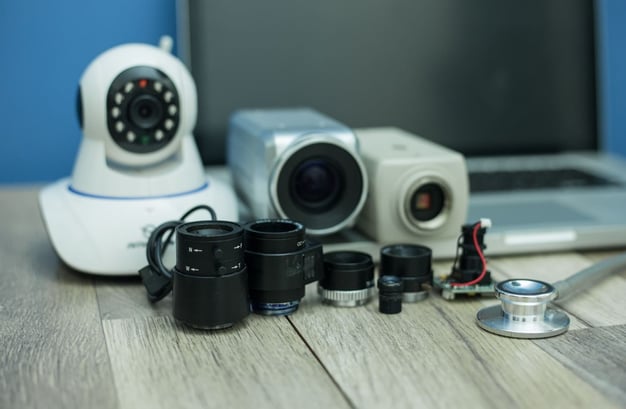
Modern commercial intruder alarm systems and CCTV networks utilise cutting-edge technology to deliver more reliable results than previous generations of equipment, so that, should an intruder gain access to your premises, there is a wealth of information to support their identification and prosecution.
In this article, we trace the history of alarms and surveillance systems to see how technology has evolved over time.
The Timeline Of Intruder Alarm And Commercial CCTV Systems
Roman Empire
While dogs are the animal of choice for homeowners to deter intruders today, the Ancient Romans relied on geese to protect their property, due to their noisy and confrontational presence. Dogs, too, were recognised for their ability to fend off intruders: cave canem mosaics were installed at the entrance to houses to warn people that a dangerous canine was resident.
1700s
The first ‘burglar alarm’ was invented by an English inventor known only as Mr Tildsley, which used a set of chimes connected to the lock of a door. If entry using the wrong key was attempted, the chimes would sound, providing an audible deterrent to scare off the intruder. The Tildsley invention is the first known example of a door-activated alarm.
1850s
In a development of the Tildsley alarm, Augustus Pope developed a system comprising electricity, magnets, and a bell to generate an audible alert if an intruder attempted to access a property via the doors of window. If entry was attempted, the electrical circuit would be closed, causing a bell to ring. Critically, the bell would continue to sound even if the door or window was closed again, giving the homeowner a clear warning of the intruder’s presence.
1942
Walter Bruch invented an early form of CCTV, the aim of which is to capture light and convert it to a video signal. CCTV operators used the technology during World War 2 to monitor V2 rockets, but it wasn’t until 1949 that CCTV became commercially available.
1960
Today, Britain has 1 per cent of the world’s population and 20 per cent of its CCTV cameras, yet surprisingly it wasn’t until 1960 that the technology arrived on our shores. In this year, the Metropolitan Police installed temporary cameras in Trafalgar Square to monitor crowds, while the first commercial use of CCTV was in a London Transport train station 12 months later.
1970s
Motion sensors were introduced during the 1970s, with the technology improved throughout the following decade. The advent of VCRs also impacted on the cost-efficiency of CCTV recording systems, as reel-to-reel systems were replaced by cheap and compact video cassettes.
2000s
Digital technology revolutionised CCTV security, offering greater storage capacity and improved image quality. Digital footage can now be stored without the need for tapes, improving accessibility and eradicating the problem of recordings being lost, damaged, or taped over.
Contact Kingdom For Bespoke Intruder Alarm and CCTV Systems
At Kingdom, we embrace the latest advances in intruder alarm and CCTV technology, delivering bespoke security solutions for our customers.
To find out more, or to request a free, no-obligation quotation, please contact us today on 0330 022 9422.
Image source: Canva



